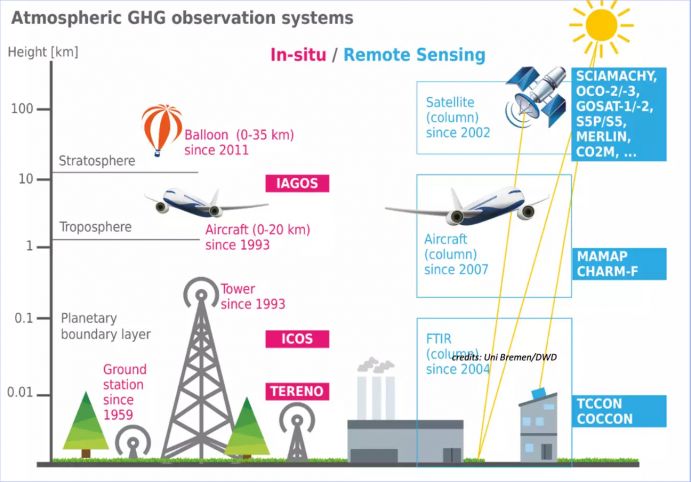Integrated Greenhouse Gas Monitoring System for Germany – ITMS
Limiting global warming and reducing greenhouse gas emissions - these goals are focus of the Paris Climate Agreement of 2015. In order to monitor the sources and sinks of greenhouse gases, the BMFTR is funding the development of an independent monitoring system.

Carbon dioxide, methane, nitrous oxide (laughing gas) and other trace gases – the worldwide emission of greenhouse gases (GHG) contributes significantly to global warming. The largest greenhouse gas sources are the energy sector, industry and transport, but also agriculture. Intact moors and forests, for example, are described as greenhouse gas sinks because they can bind CO2. In the Paris Agreement of 2015, a total of 195 countries agreed to limit global warming to 1.5 °C if possible and to reduce emissions and minimise the consequences of climate change in order to achieve this. But how can greenhouse gas emissions be monitored and documented nationally?
In Germany, the Federal Ministry of Research, Technology and Space (BMFTR) is committed to an independent "Integrated Greenhouse Gas Monitoring System for Germany – ITMS" and has been funding its development since December 2021. The aim is to determine, quantify and classify anthropogenic – man-made – and natural greenhouse gas sources and sinks throughout Germany. The focus here is on Germany's most relevant greenhouse gases: carbon dioxide, methane and nitrous oxide (laughing gas). All information obtained through the Integrated Greenhouse Gas Monitoring System is to be made available online and visualised. With the help of the information provided, policymakers can regularly review and adjust the effectiveness of climate protection measures.
The objectives of the Integrated Greenhouse Gas Monitoring System (ITMS) are:
- Provide and visualise spatially and temporally resolved, sector-specific data on natural and anthropogenic greenhouse gas sources and sinks online.
- Support the German government in monitoring and reporting on natural and anthropogenic greenhouse gas sources and sinks in Germany, in particular in national reporting and scientific verification for carbon emissions trading.
- Identify and correct over- and underestimation of sources or sinks (i.e., emissions or uptake) as well as regional hotspots.
- Differentiation of natural and anthropogenic contributions of greenhouse gas sources and sinks, such as in agriculture, forestry or transport.
- Transferability of the developed ITMS concept – or parts of it – for the implementation of greenhouse gas monitoring systems to other countries.
To ensure the most successful development of ITMS, the funding measure builds on an implementation concept (concept only in German available) that was written by a national expert group together with international experts. This concepts builds upon a core project that is responsible for the overall technical coordination of the ITMS. Due to many years of expertise and preliminary work in this subject area, as well as the assumption of responsibilities in the operational running of the ITMS, the Max Planck Institute for Biogeochemistry (MPI-BGC) and the German Weather Service (DWD) take on this coordination function.
With projects of a supplementary announcement, the ITMS core project was expanded by further, associated research projects on selected topics. In particular, innovative and additional observation methods and modelling approaches are to be developed, tested and applied. The aim is to integrate suitable and tested observation and modelling methods into the new ITMS system to be developed.
The ITMS is based, for example, on the data collected on greenhouse gases from the BMFTR-funded research infrastructures ICOS (Integrated Carbon Observation System) and IAGOS (In-service Aircraft for a Global Observing System), which are incorporated into the monitoring system. The development of the German contribution to ICOS was funded by the BMFTR from 2012 to 2016 and the contribution to IAGOS from 2012 to 2022.
As early as 1992, when the Framework Convention on Climate Change was adopted, the Parties undertook to compile comparable national inventories of their greenhouse gas emissions – in particular to assess the implementation and effectiveness of climate protection measures. Building on the national reporting and verification regimes developed over the past decades, an enhanced transparency framework with extended reporting obligations was established under the Paris Agreement in 2015, allowing for a more comprehensive comparability of greenhouse gas inventories and assessment of announced Nationally Determined Contributions (NDCs). At the World Climate Conference in Glasgow at the end of 2021, the Parties agreed on rules on modalities, procedures and guidelines for measurement, reporting and verification that are still missing.
Reliable national reports on greenhouse gas emissions are essential for the implementation of the Paris Agreement. The BMFTR will contribute to this by establishing an "Integrated Greenhouse Gas Monitoring System for Germany – ITMS". This will serve to independently monitor greenhouse gas sources and sinks in Germany.
The BMFTR is coordinating closely with the Federal Ministry of Transport (BMV) and the Federal Ministry for the Environment, Climate Action, Nature Conservation and Nuclear Safety (BMUKN). The national ITMS initiative is also guided by the framework for an integrated global GHG information system (IG3IS) developed by the World Meteorological Organization (WMO) with its recommendations for national contributions.
As part of the "Research for Sustainability" (FONA4) strategy the BMFTR is funding research and development projects to establish an Integrated Greenhouse Gas Monitoring System (ITMS) for Germany. In the FONA strategy, the funding priority thus contributes in particular to Goal 1 "Achieve climate goals" and Field of Action 3 "Knowledge for effective climate policy". The funding also makes a significant contribution to the implementation of the Future strategy for research and innovation through innovative developments for the establishment of the ITMS.
Last updated on




